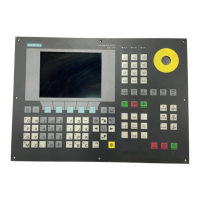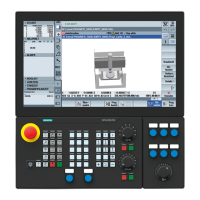K1: Mode group, channel, program operation, reset response
9.10 Asynchronous subroutines (ASUBs), interrupt routines
Basic Functions
602 Function Manual, 09/2011, 6FC5397-0BP40-2BA0
REPOS-query
Interrupt routines sequences may be generated for which there is no unambiguous return to an interruption point
in the block processing sequence (REPOS).
The system variable $P_REPINF can be used to scan the ASUB to determine whether a REPOS is possible.
Determine cause of activation
With the system variable $AC_ASUP the cause leading to the activation of an intrerrupt routine, is specified bit-
coded and can be read in the part program and in synchronous actions (see "Programming [Page 605]").
Flexible programming
The following commands help in the flexible programming of interrupt routines:
References
Programming Manual, Job Planning; Chapter: "Flexible NC Programming" > "Interrupt routine (ASUB)"
Value Description
0 Repositioning with REPOS not possible because:
• not called in ASUB
• ASUB ran from reset status
• ASUB ran from JOG
1 Repositioning with REPOS possible in ASUB
Command Description
SAVE If the SAVE command has been used to define the interrupt routine, the G
codes, frames and transformations previously active in the interrupted
part program become operative again as soon as the interrupt routine is
ended.
DISABLE The DISABLE command can be set to protect part program sections from
being interrupted by an interrupt routine.
The assignment interrupt signal ↔ part program is maintained but the
interrupt routine no longer respond to the 0/1 signal transition.
ENABLE The DISABLE command can be reset with the ENABLE command.
Interrupt routines are not activated until the next 0/1 transition of the
interrupt signal.
CLRINT Clear assignment Interrupt signal ↔ part program

